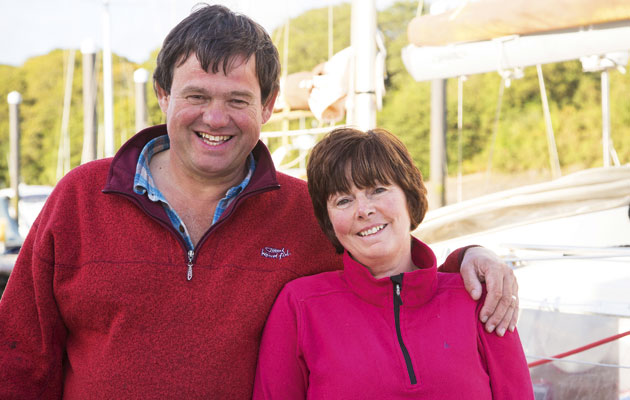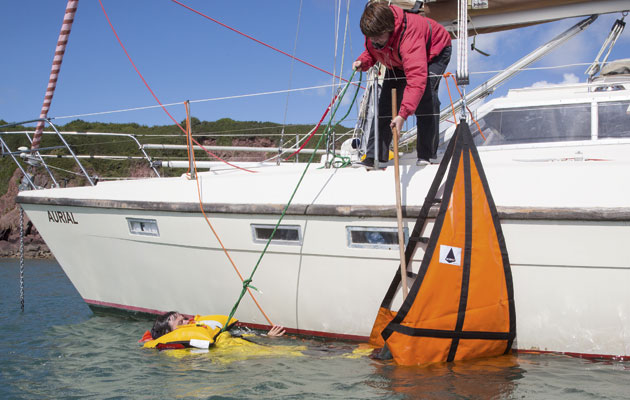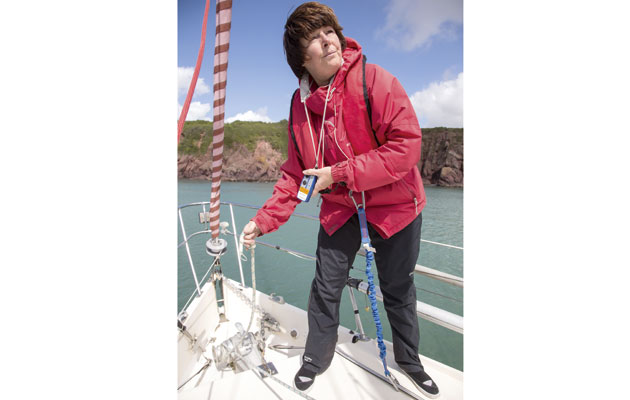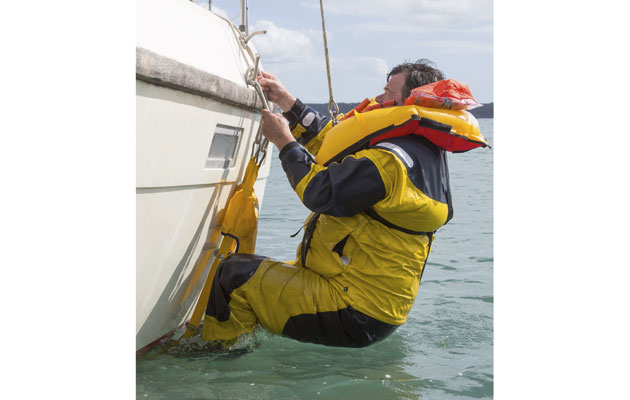Could a wife save her husband’s life? Yes, but the key is a tried, tested and trusted plan, says Chris Beeson
This should interest every cruising couple because statistically it’s likely that the man is stronger and heavier than the woman. Some will say that’s sexist, others genetics. Whatever it is, if the stronger, heavier crew goes over the side, the weaker, lighter crew needs to put into action a plan that will get the man overboard (MOB) back in the cockpit.
Even in the warmest British summer, in our temperate latitudes, a normally clothed person has maybe an hour to get out of the water before things start going irretrievably wrong. That sounds like a long time but if you don’t have a tried and tested plan that you both know will work, panic sets in, bad decisions get made and time quickly slips away as the MOB deteriorates.
Ideally we wanted to find a method of MOB recovery that was reliable, quick and physically easy. Luckily we found a willing couple: Carol and Jonty Pearce, regular YM contributors who sail their Southerly 105 ketch Aurial from Neyland Marina on Milford Haven. Jonty, a GP, is built like a bunker and tips the scales at 20 stone. Carol, a teacher, weighs just eight stone and, I’m delighted to say, is recovering well from chemotherapy, though still to return to full fighting fitness. They are the perfect couple to demonstrate that, if planned and practised, it can be done.
Plan to save your life
UK waters vary from 5°C in winter to 18°C in a good summer. The average clothed person can spend about one hour in the water before incapacity becomes critical. and chances of survival nosedive.
The initial cold shock of immersion triggers a gasping reflex, which can lead to drowning. It also raises blood pressure to levels dangerous for those at risk of heart attack or stroke as the heart beats faster to increase circulation. Then heart rate and respiration steady but shivering starts, where energy is expended to warm the blood. As the body loses heat 25 times quicker in water than in air, the body cannot maintain its core temperature, even though shivering becomes dramatic. Hands and feet become numb as blood stops circulating to the limbs and the body tries to focus warmth in the core organs. Physically, you can no longer help yourself.
Every minute an MOB is in the water, the chances of safe recovery diminish so it’s critical to plan, practise and fine-tune your recovery method.
Unexpected snags
Jonty found swimming in a lifejacket very difficult. His kicks were ineffective so he sculled on his back. There was no need for a sprayhood in such benign conditions. He needed to swim because a slight current took him away from the anchored boat. As a yacht at sea offers a lot more windage than an MOB, drift would be an issue so Carole decided that her first priority was getting a line to Jonty so that she could set up the recovery system without him drifting off.
What MOB recovery kit is available?
In terms of useful kit Aurial has a handy-billy, an inflatable tender and an MOBmat – a stretcher in a sling rather than a parbuckling device that compresses the MOB’s chest. She has a stern ladder and a webbing ladder that clips on close to the shrouds. She doesn’t have a lifesling so Ocean Safety loaned us a Kim MOB Rescue Sling, the best overall buy in our test of MOB recovery kit (YM Sep 12).
Several recovery plans rely on the power of the person on deck. The handy-billy offers 7:1 mechanical advantage. Aurial’s primary winch offers 40:1 and her halyard winch 8:1. There’s also a 1,200W electric windlass.
We motored out Neyland and headed west to a sheltered anchorage in Butts Bay, on the north side of the estuary. With a wetsuit under his oilies to protect against the cold, Jonty went in a total of 10 times as a conscious MOB and Carol tried to fish him out.
‘Before my illness, I was very fit for my age (I’m now 54), sailing, cycling and walking, and I was mentally and physically on-the-go running a school biology department,’ Carol explained. ‘The real surprise is that it’s taken me more than two years recover from surgery, chemo, radio, immunotherapy and medication.
‘So today I would say my energy and stamina are 80 per cent of what they were before my illness. Joints, tendons and muscles are only 90 per cent normal.
‘One other problem is that the grip of my dominant right hand has been badly affected by a torn tendon, so winching isn’t easy.’
The test
Halyard clipped to a harness
Prep time 30 secs
Recovery time N/A
Though simple and quick, this method was a non-starter. Aurial has 8:1 halyard winches at the mast. The gearing isn’t nearly high enough for Carol to winch Jonty up, and no self-tailer means you can only winch one-handed. Nor were any of Aurial’s halyards long enough to reach the MOB with enough tail for three or four turns on the winch.
Handy-billy and harness
Prep time 4 mins
Recovery time 7 mins
Jonty and Carol had high hopes for their 7:1 handy-billy as, with its tail led to the 40:1 primary winch, the 280:1 mechanical advantage makes the loads manageable for Carol.
It’s stowed block-to-block, so she took it to the shrouds, clipped the bottom to the chainplates and a halyard to the top. The tail is led from the top block to a primary winch via a block shackled to the chainplates and another on a stanchion base further aft. She winched the halyard to pull the blocks apart then lowered and cleated the halyard so that the handy-billy’s bottom block reached the MOB.
Jonty clipped the shackle to his lifejacket’s D-ring (working blind because of the inflated lifejacket) and Carol started winding. And winding.
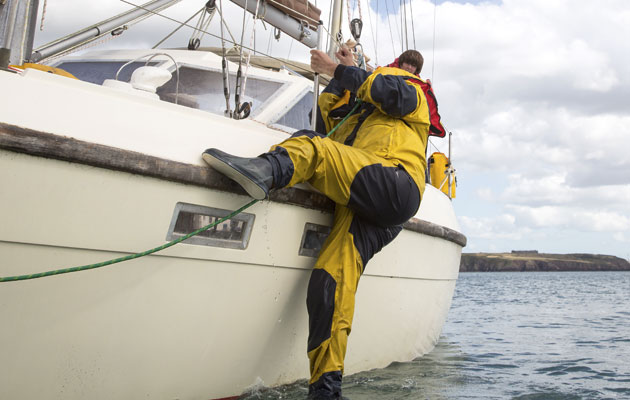
With a foothold on the topsides, Jonty dragged himself aboardJonty clipped the shackle to his lifejacket’s D-ring (working blind because of the inflated lifejacket) and Carol started winding. And winding.
After 180 turns, mostly in low gear and punctuated by rests, Jonty swung a foot over the high topsides and scrambled aboard. His lifejacket’s padded crotch strap made things more bearable than they might have been but the harness really squeezed his chest – he reported serious discomfort.
Handy-billy and MOBmat
Prep time 8 mins
Recovery time 15 mins
This is what their handy-billy was designed to do. Its line is long enough to allow the bottom block to reach the deployed MOBmat’s lifting strops, the tail to form at least four turns on the primary winch and the top block to be high enough that, when block-to-block, the MOBmat can swing over the lifelines and onto the coachroof (Aurial’s sidedecks are too narrow). There’s a black mark on the halyard to ensure that the top block is high enough.
After setting up the handy-billy (4 mins) Carol set up the MOBmat (another 4 mins). Jonty the GP pointed out that this is the only horizontal MOB hoist, avoiding the blood pressure drops, cardiac strain and chest compression of vertical lifts. It’s also the only option if you have an unconscious MOB. Unless you can secure a line to the MOB to stop them drifting off and make them manoeuvrable, you would need to set up the MOBmat first then manoeuvre them with a boathook. With Jonty playing possum, it was tricky to get him into the sling, though the orange lines weren’t used as intended, to move the mat under the MOB.
Then Carol laboured through 260 turns, again mostly low gear.

Halyard stretch meant the handy-billy was block-to-block but Jonty was still too low to get over the lifelines
However, with the handy-billy block-to-block, halyard stretch meant he was too low to swing the MOBmat onto the coachroof. He had to climb out onto the sidedeck.
Halyard and windlass
Prep time 3 mins
Recovery time N/A
I had high hopes for this one but problems soon emerged. First, none of Aurial’s halyards was long enough to reach the MOB at one end and the windlass at the other. We used a length of gash line to extend the halyard’s working end. Also, as Aurial has no blocks at her mast base, we had to loop the halyard clockwise round a mast-mounted winch and lead it forward to the windlass’ rope drum. After Jonty slipped into the rescue sling, Carol pressed the remote control while tailing the halyard.
Two problems emerged. First, the lead from the halyard winch to the windlass wasn’t fair, resulting in several riding turns.
We used a snatchblock to change the lead, solving that problem, but then the windlass kept tripping.
Carol could have deployed the handy-billy, reducing load to prevent tripping, but the whole set-up was too complicated and unreliable already, even without a 7:1 purchase system. This didn’t work on Aurial. On the plus side, Jonty reported the rescue sling was much more comfortable than the lifejacket harness.
Bathing ladder
Prep time 10 secs
Recovery time 10 secs
As the bathing ladder is designed to help you get out of the water it’s no surprise that it proved very quick to deploy and equally simple to use. Jonty reported that it was a bit more of a strain than usual, thanks to pockets full of Milford Haven, but it wasn’t a problem. Indeed Jonty used the stern ladder to get himself out of the water 10 times on the day, with no fuss.
And that’s all well and good in an anchorage or a flat calm, a bathing ladder is perfect for that. Indeed if you can lower the ladder from the water, you needn’t even trouble your crew. If, however, you’ve had the misfortune to go over the side accidentally in anything more than a gentle swell, which is a considerably more likely scenario, the stern will be rising and falling. Try to use the bathing ladder in these conditions and you have a range of injuries to choose from: a dislocated shoulder, elbow or wrist if you do manage to get a grip on the ladder, or a fractured skull if the transom comes down on your head with a force of several irresistible tons.
Recovering a conscious and fully able MOB is difficult enough, it would be madness even to risk shortening the odds still further. In any sort of sea, you can forget about the transom bathing ladder.
Webbing ladder
Prep time 30 secs
Recovery time 6 mins
The drawback of the bathing ladder is its location at the stern where pitching is at its worst. A better location would be the shrouds: no edges and at the centre of the pitching axis (ignoring roll for now). From their E Boat-owning days, Jonty and Carol have a webbing ladder with four plastic steps. Clip its bag to the chainplates and the MOB can grab the release loop and climb the ladder.
As usual it’s not so simple. First, Aurial has high topsides so the bottom rung barely reaches the water. Getting a foot in the rung proved impossible. Carol tied bowlines in both ends of a length of line, draped it round the chainplates and clipped the ladder to the bowlines. This gave Jonty a fighting chance of getting his feet in the rungs, and fight he did.
The next problem is that Jonty was climbing an overhang because his feet were under the turn of the bilge, loading his arms, and the high topsides meant he couldn’t grab anything useful.
Climbing became easier when Carol passed him a halyard to clip on and started winching him up. We could have reduced the angle and given him a bigger step if we had a fender horizontally under the ladder at water level, secured with lines.
Tender
Prep time 30 secs
Recovery time 30 secs
This is a bit of a cheat as it doesn’t get the MOB back aboard, but it does get them out of the water and that significantly slows the rate of heat loss and buys time for the crew to set up and deploy the method they will use to get the MOB back on deck.
A second cheat is that Aurial’s tender was both inflated and in davits on the stern. Some might tow their tenders but in stiffer conditions they’re usually deflated and bagged up in a locker. Inflating and launching it would take too long. If it’s inflated and afloat alongside, not at the stern, it’s an option.
First he tried to get a leg over the side but the tender flipped, leaving Jonty relieved that he’d removed the outboard, which would have hit him in the head. Would replacing boots with swim fins have helped him in? Absolutely – but can you reach your feet while wearing a lifejacket? Probably not.

With Carol to counterweight the tender and grab a leg, he did manage to board, though both crew were then off the yacht
Carol jumped in and sat on the opposite side, stabilising the tender, and grabbed Jonty’s leg when he flung it over the tube, enabling him to get some leverage. After 10 seconds of struggling, Jonty was in the tender.
The immediate concern here is, if the MOB can’t board the tender without help, the only crew left on board needs to get off the boat and into the tender. It’s easy to imagine two MOBs and no-one on deck.
The easiest, quickest man overboard recovery method is…
As this and other MOB recoveries have shown, it depends on you: on your relative strengths and weights, whether your halyards lead back to the cockpit, whether you have electric winches, how high your topsides are. There is a huge range of variables to consider for each couple and
yacht. The only way to find out what works for you is to spend a few evenings coming up with ideas, then set aside a summer weekend, anchor in a quiet bay and practice until you’re both confident with your chosen method of recovery.
If you ever have to recover your MOB in earnest, that confidence will keep you both calm and working together effectively.
I’m still convinced that, if you have an electric windlass, that’s likely to be the best method of recovery: it’s quick to set up (once you’ve worked out how to get a fair lead and possibly extended your halyard or topping lift), fast and zero effort. It didn’t work for Carol, perhaps because she lacks the confidence to use it. When anchoring it’s always Jonty that manages the ground tackle so Carol isn’t familiar with the windlass’ workings. Even if she was, the windlass would still trip every five seconds, though if the engine was running, the alternator would help the batteries handle the load. Whatever the reason, it’s not a method they trust and they’re not going to use it.
What’s best for Jonty and Carol?
Debriefing after the day’s activity, both were relieved that she had managed to get him out. The best option for them was the handy-billy and either the rescue sling (they have decided to buy one as it’s both a retrieval and recovery device, and it’s more comfortable than a harness hoist) or the MOBmat.

Depending on the situation, they will use either the MOBmat or the Rescue Sling with the handy-billy
Even in this controlled environment, Carol was feeling the pressure and took a while to set up the handy-billy, so they have lengthened the line and simplified the set up by stowing the handy-billy coiled in a bucket but ready-extended, with the falls tied to avoid tangles. They’re also thinking about self-tailing halyard winches or an electric primary winch, and a Dyneema halyard to avoid the problem of stretch.
The main lesson Carol learned was the need to secure the MOB alongside first, to stop them drifting off once recovered. She is also determined to find out how to manoeuvre an unconscious MOB into the MOBmat. The easiest option seems to be somehow using a boathook (though it needs to be long enough to reach into the water) to prod a bight of line over the MOB’s head and shoulders and up under the armpits, allowing them to be hauled into the MOBmat. As we motored back, Carol and Jonty were already redesigning their handy-billy and tweaking their recovery method. And that’s what everyone needs to do.





